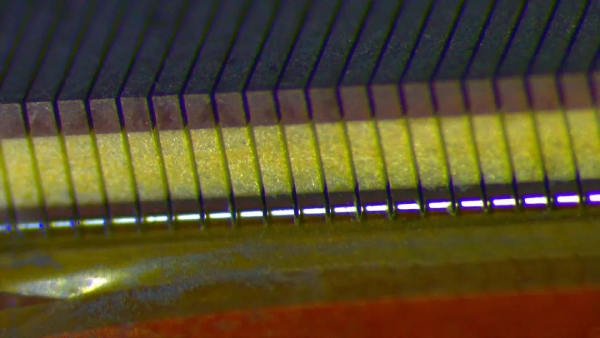How to choose an ultrasound probe? Uncover the cutting-edge technology and product advantages of France's Vermon!
Release Time:
2025-05-05 00:00
Ultrasound imaging technology is a vital tool in modern medical diagnostics, and the performance of its core component—the ultrasound probe—directly determines imaging quality. With 41 years of technical expertise, France's Vermon holds significant influence in the global OEM ultrasound transducer market. Today, let’s explore how this company, backed by a 400-strong professional team, drives innovation to deliver 150,000 high-quality probes annually to over 500 clients worldwide.
一. Key Factors Determining Ultrasound Probe Image Quality
The image quality of an ultrasound probe fundamentally represents a dynamic balance and optimization among resolution, penetration depth, and sensitivity. These three factors are interdependent yet mutually constraining, collectively determining the final imaging performance.
1. Resolution vs. Penetration Depth
a.There exists an inherent physical trade-off between resolution and penetration depth:
b.Resolution: Should match the target organ's dimensions
c.Penetration Depth: Must cover the required diagnostic depth range
d.Clinical Selection Principle: Prioritize diagnostic needs by ensuring sufficient resolution first, then maximize penetration depth within that constraint.
2. Bandwidth: The Critical Factor in Resolution Optimization
Key Formula:
Axial resolution (δz) correlates with probe bandwidth (BW):
a.Simplified: δz ≈ 0.77/BW (unit: mm)
b.Example: 40% BW @5MHz → δz=0.46mm 100% BW @5MHz → δz=0.15mm
c. Practical Correction Formula: δz = √[(0.3/BW)² + (0.77/f₀)²]
When BW > 0.4f₀, bandwidth becomes the dominant factor determining resolution.
3. Sensitivity: The Critical yet Often Overlooked "Invisible Metric"
Sensitivity directly determines a system's ability to detect weak echo signals. For small animal imaging (mice/rats), it holds even greater significance for image quality and quantitative analysis, often surpassing traditional metrics like resolution.
Five Key Influencing Factors:
a.Electromechanical Conversion Efficiency
b.Signal-to-Noise Ratio (SNR)
c.Frequency and Bandwidth
d.Array Element Matching Design
e.New Materials and Advanced Manufacturing Processes

二. Material Innovation: Breakthrough Performance with Single Crystal Technology
Modern single crystal probes can simultaneously enhance both bandwidth and sensitivity, breaking through traditional limitations to make "high resolution + deep penetration" a reality.
Single Crystal Probes: Represent a major advancement in ultrasound technology, with their core advantages stemming from the superior performance of single crystal piezoelectric materials.

Three Unique Advantages of Single Crystal Probes:
-
1. Superior Thermal Stability: Minimal structural defects → Enhanced environmental, adaptabilityMaintains consistent performance across extreme temperature ranges (-20°C to 85°C)
- 2. Extended Service Life: Significantly slower material degradation rat, Proven durability through 10+ million operational cycles
-
3.Low-Voltage Operation: Delivers high acoustic output at reduced driving voltages, Enables development of more compact ultrasound systems, Enhances portability for point-of-care applications
Single Crystal Probes: Revolutionizing Ultrasound Performance Beyond Conventional Piezoceramics
| Performance Specifications | Piezoelectric Ceramics | Single Crystal Materials | Magnitude of Improvement |
| Electromechanical Coupling Coefficient | 0.45-0.50 | 0.85-0.92 | 80-100% |
| Piezoelectric Parameters | 500-600 | 2000-2500 | 3-4Times |
| Dielectric Parameters | 3000-4000 | 5000-8000 | 1.5-2 Times |
| Energy Conversion Efficiency | 50% | 85% | Significant Improvement |
| Bandwidth | 60-80% | 80-120% | Wider Frequency Bandwidth |
Breakthroughs in Single Crystal Probes: Achieving the Perfect Balance Between Bandwidth and Sensitivity
Realizing the Ideal "High Resolution + Deep Penetration" Combination
三. Core Technological Breakthroughs in Vermon's Rodent Probes

01. 256-Element High-Density Array
-
a. Significantly enhances imaging precision
-
b. Optimized signal acquisition efficiency
-
02. Multi-Layer Matching Technology
-
a. 6-layer design boosts energy transfer efficiency from 50% (conventional 2-layer) to >90%
-
b. Gradual Acoustic Impedance Transition Design
-
c. High-frequency signals exhibit greater sensitivity to matching layers. The multilayer design prevents filtration of high-frequency components, preserving high-resolution imaging capabilities.
-
03. Sensitivity Optimization System
-
a. Base material:
✓ High kt single crystal (2-3× improvement vs PZT) -
b. Design Architecture: 6-Layer Matching System + Low-Noise Circuitry
-
c. Significant Improvement in Overall Signal-to-Noise Ratio (SNR)
四. Customer Adoption: The Ultimate Benchmark of Technical Excellence and Reliability
Vermon, a French company, serves as a key supplier of high-frequency medical ultrasound probe technology. Its clientele includes globally renowned medical device manufacturers, research institutions, and specialized healthcare facilities. Although Vermon has not publicly disclosed its complete customer list, a review of available literature reveals that major international medical technology companies such as **GE Healthcare, Siemens Healthineers, and Philips** are among its clients






